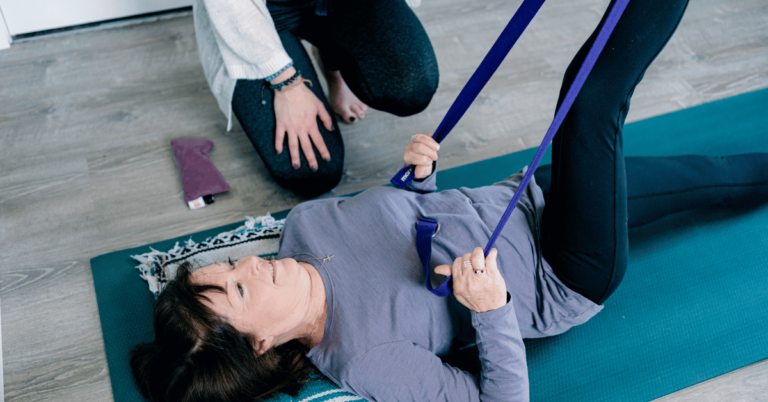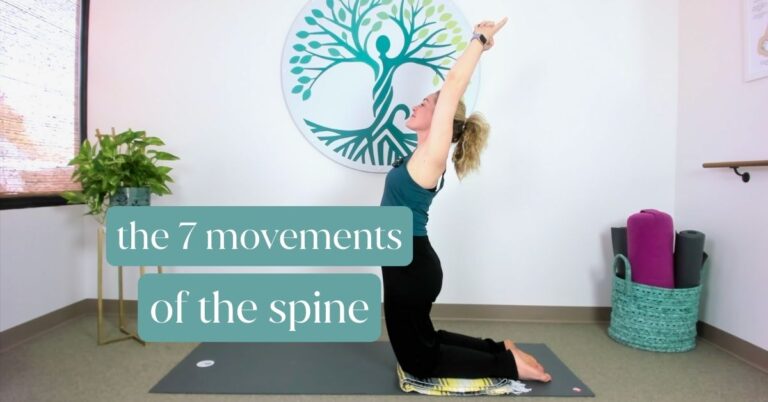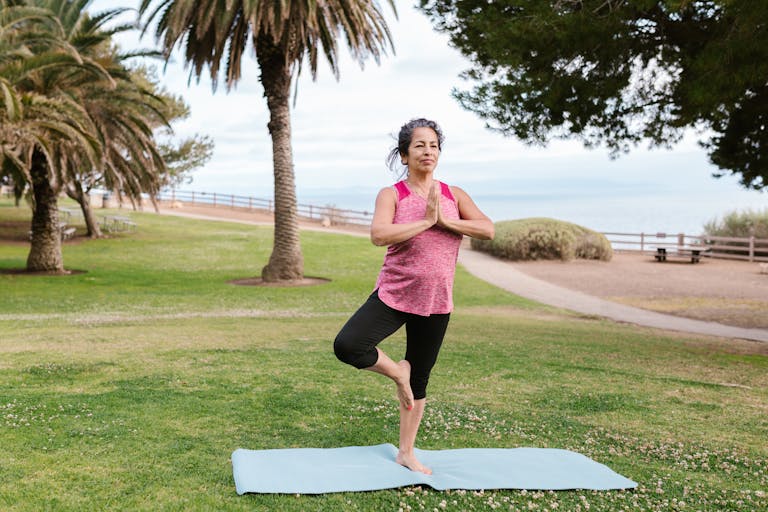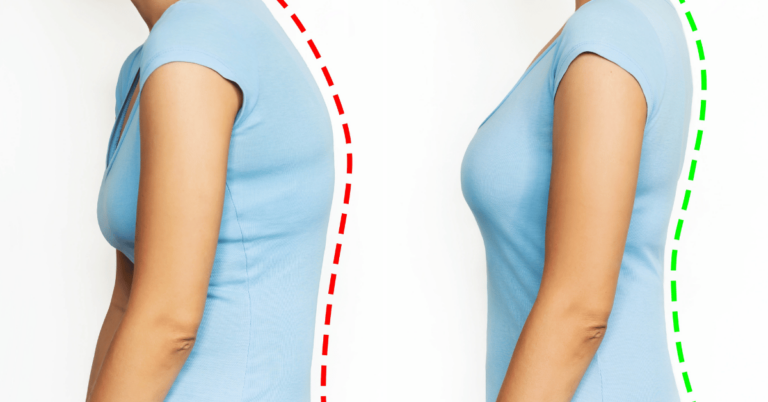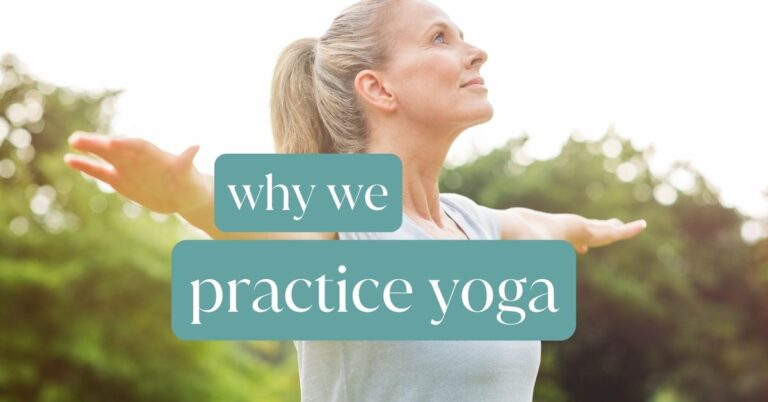Lifelong Yoga’s 4 Core Pillars
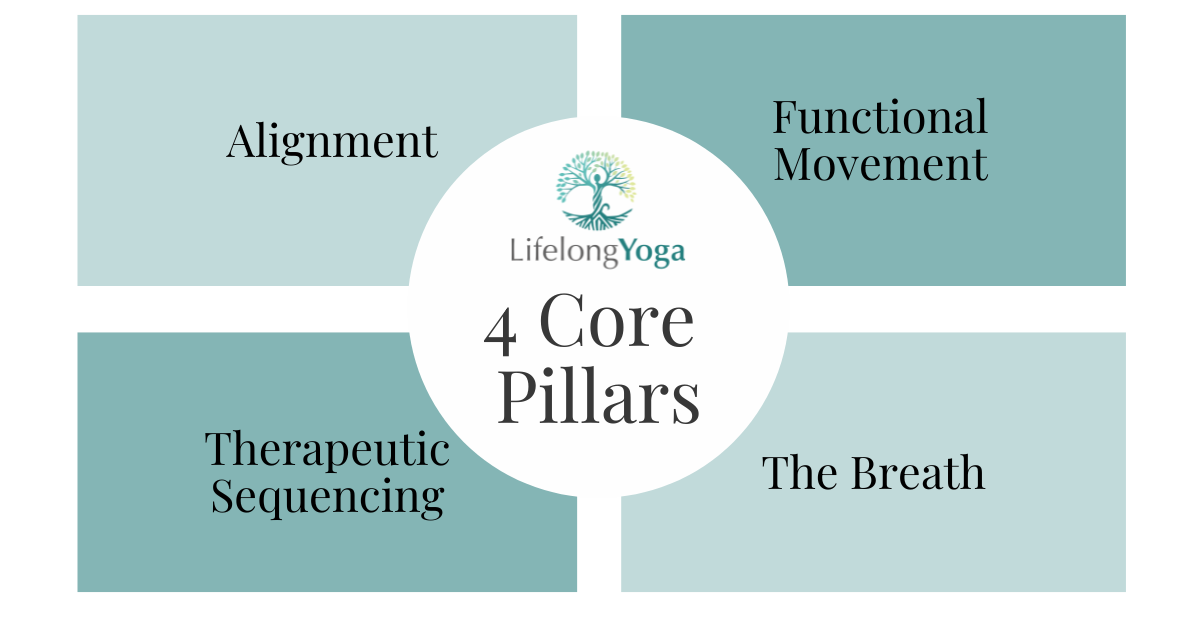
4 Core Pillars for Optimal Health and Vibrance
At Lifelong Yoga, there’s a focus on 4 Core Pillars for Optimal Health and Vibrance: Alignment, Functional Movement, The Breath, and Therapeutic Sequencing. These four pillars are present in every group class I teach, every 1:1 yoga session, and every online program.
Pillar #1: Alignment
Find YOUR ideal alignment
In Lifelong Yoga classes, we don’t rush from pose to pose, instead we take our time to explore the little details and different ways of being in each posture. I believe that there is no such thing as perfect alignment, so instead we focus on finding the best alignment for YOU and your body.
There is no such thing as perfect alignment. Instead, find the best alignment for you and your body.
Mikah Horn
Take, for example, Warrior I.
I might keep a student in Warrior I and spend some time exploring how it feels and if we can change anything to make the pose feel better and to get more benefit out of it.
I might ask:
How does it feel if you change the angle of your back foot? Does that bring some ease to the knee joint?
Or if you tried turning your palms facing inward – how would that affect your shoulders?
What if you root through your front foot’s heel a little more to shift some of the muscle engagement to the glutes? How does that feel?
This exploration leads to more self-awareness and a deeper sense of connection with your body over time.
Have fun with props
Props are such a fantastic way to explore alignment, to modify poses, and to elevate your practice by adding extra resistance and proprioceptive input (body awareness). We’ll use all of these and more in Lifelong Yoga classes: Yoga blocks, straps, chairs, therapy balls, bolsters, blankets, the wall, the barre.
Pillar #2: Functional Movement
To describe what I mean by functional movement in simple terms: This is yoga for your LIFE.
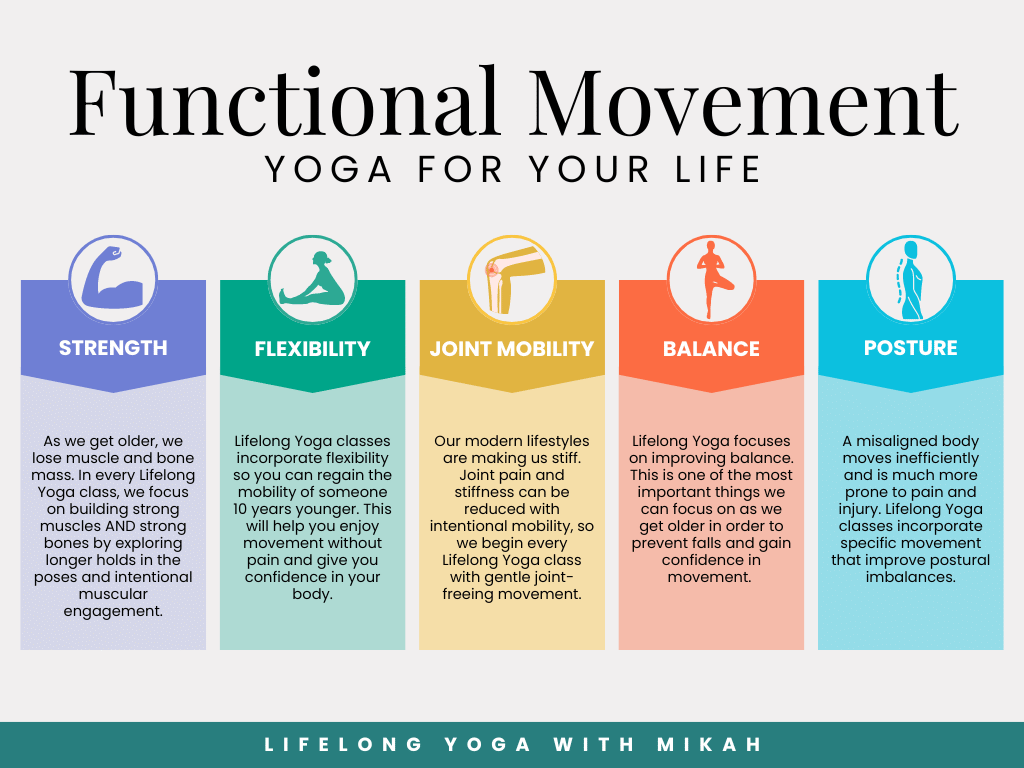
This is flexibility not just for flexibility’s sake, but so you can relieve tightness that’s restricting your daily activities. This is building strength to get up and down off the floor to play with your grandchildren with ease. This is joint mobility so your joints don’t ache in the morning when you first wake up.
There are 5 specific elements I consider as part of functional movement, so I’ll go into a little more depth here on each one.
Strength
As we get older, we lose muscle and bone mass. So in every Lifelong Yoga class, we focus on building strong muscles AND strong bones! To do this, we explore longer holds in the poses and intentional muscular engagement for added strength and stability.
Flexibility
Can you get up and down from the floor without using your hands? Can you sit cross-legged comfortably? Lifelong Yoga classes incorporate flexibility so you can regain the mobility of someone 10 years younger. This will help you enjoy movement without pain and give you confidence in your body.
Joint mobility
Our modern lifestyles are making us stiff. Joint pain and stiffness can be reduced with intentional mobility, so we begin every Lifelong Yoga class with gentle joint-freeing movement. This helps with circulation and synovial fluid production (which lubricates the joints).
Balance
Lifelong Yoga focuses on improving balance because I believe that this is one of the most important things we can focus on as we get older in order to prevent falls and gain confidence in movement.
Posture
If you look at most bodies these days, you’ll often see a forward tilted pelvis (anterior tilt), sway back, rounded shoulders, a tech neck, and sometimes a hunchback. Postural imbalances often begin early in life and become problematic by middle age. A misaligned body moves inefficiently and is much more prone to pain and injury. Lifelong Yoga classes incorporate specific movement that improve postural imbalances.
Pillar #3: The Breath
Breath awareness
Yoga isn’t yoga without a focus on the breath. Simple breath awareness leads to a deeper connection with our body (inside and out). When we focus on our breath, we’re not just going through the motions like you could in any exercise class, but instead we’re fully present.
Yoga isn’t yoga without a focus on the breath.
Mikah Horn
Optimal breathing patterns
I’ve found that many of my students are mouth breathers and/or reverse breathers, so I also focus a lot on optimal breathing patterns. Inefficient breathing habits can lead a dysregulated nervous system and health issues over time. I encourage diaphragmatic breathing and nasal breathing in class (and in your daily life).
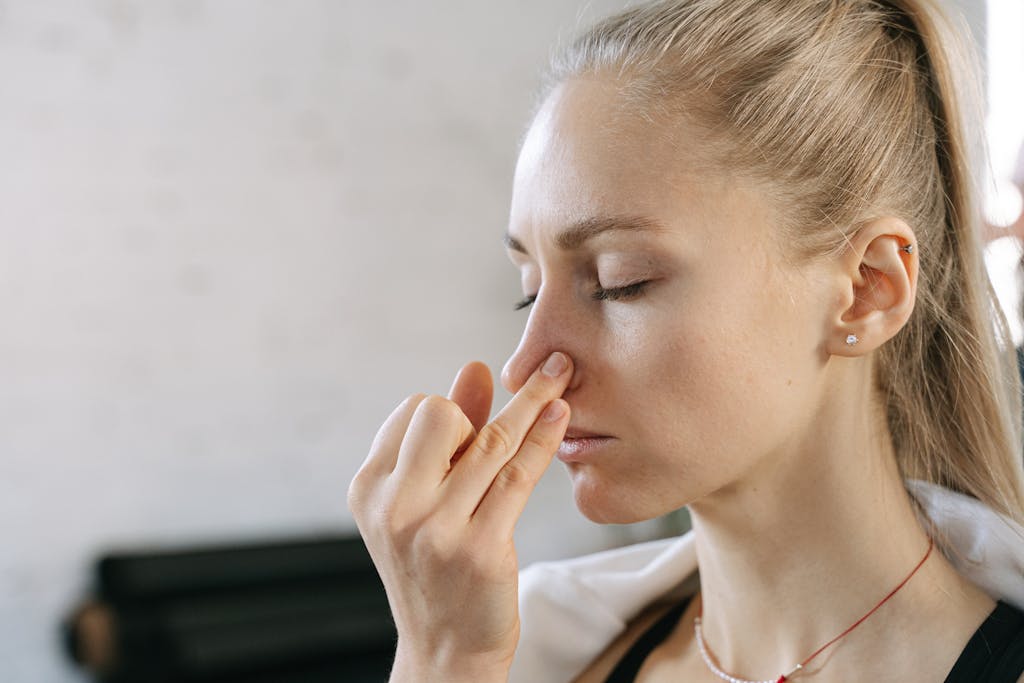
The breath is so powerful. A change in your breath can change how you feel immediately. We can manipulate the breath to change our energy and our state. We can use the breath to find balance and build resilience.
Pillar #4: Therapeutic Sequencing
There’s a specific 5-part sequence that I use in all of Lifelong Yoga’s classes. We begin with releasing, then we mobilize our joints, then we move on to strengthening, then stretching, and we end each session with restoration.
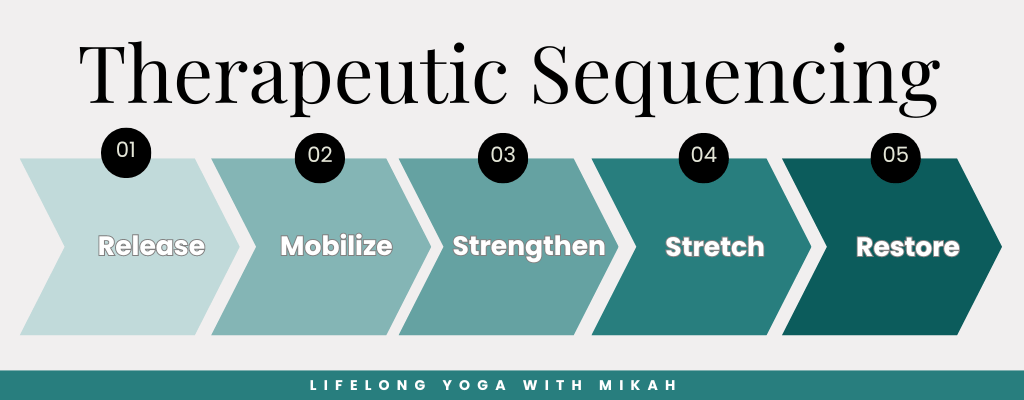
1. Release
Every Lifelong Yoga class starts with a few minutes of centering where we intentionally release and reset. We may release tension from the body, but we also release our day, our to-do list, our worries, and anything else that’s on our mind. This time spent preparing for our yoga practice can be a combination of breath, intention setting, body scanning, and progressive muscle relaxation (tensing and releasing areas in the body).
2. Mobilize
Next, we spend exploring a variation of something called a “joint-freeing sequence,” which Increases synovial fluid around the joints, relieves any joint stiffness, warms up the body, and increases circulation. This is also the part of class where I’ll guide you through the 7 different movements of the spine because “you’re only as young as your spine is flexible!”
3. Strengthen & Stabilize
When you think about yoga, you might think of stretching and flexibility first, when in reality most people could use more of a focus on strength and stability. This is the part of class where we’ll do any core work (like Boat Pose), we’ll practice Warrior poses where we explore lower body strength, we’ll work on our balance, and explore longer-held poses that focus on building overall strength and stability in the body.
4. Stretch
Finally, near the end of class is when we focus on flexibility! If you want to become more flexible, it’s important to include passive, longer-held stretches with breath awareness to turn off your nervous system’s stretch reflex and allow your body to soften. Muscles stretch best when they are relaxed. Most of the poses for flexibility we do in Lifelong Yoga classes are held for at least 45-60 seconds.
5. Restore
I always end class with Savasana or some kind of intentional relaxation. This allows your nervous system to shift into the relaxation response where you can truly rest and heal.
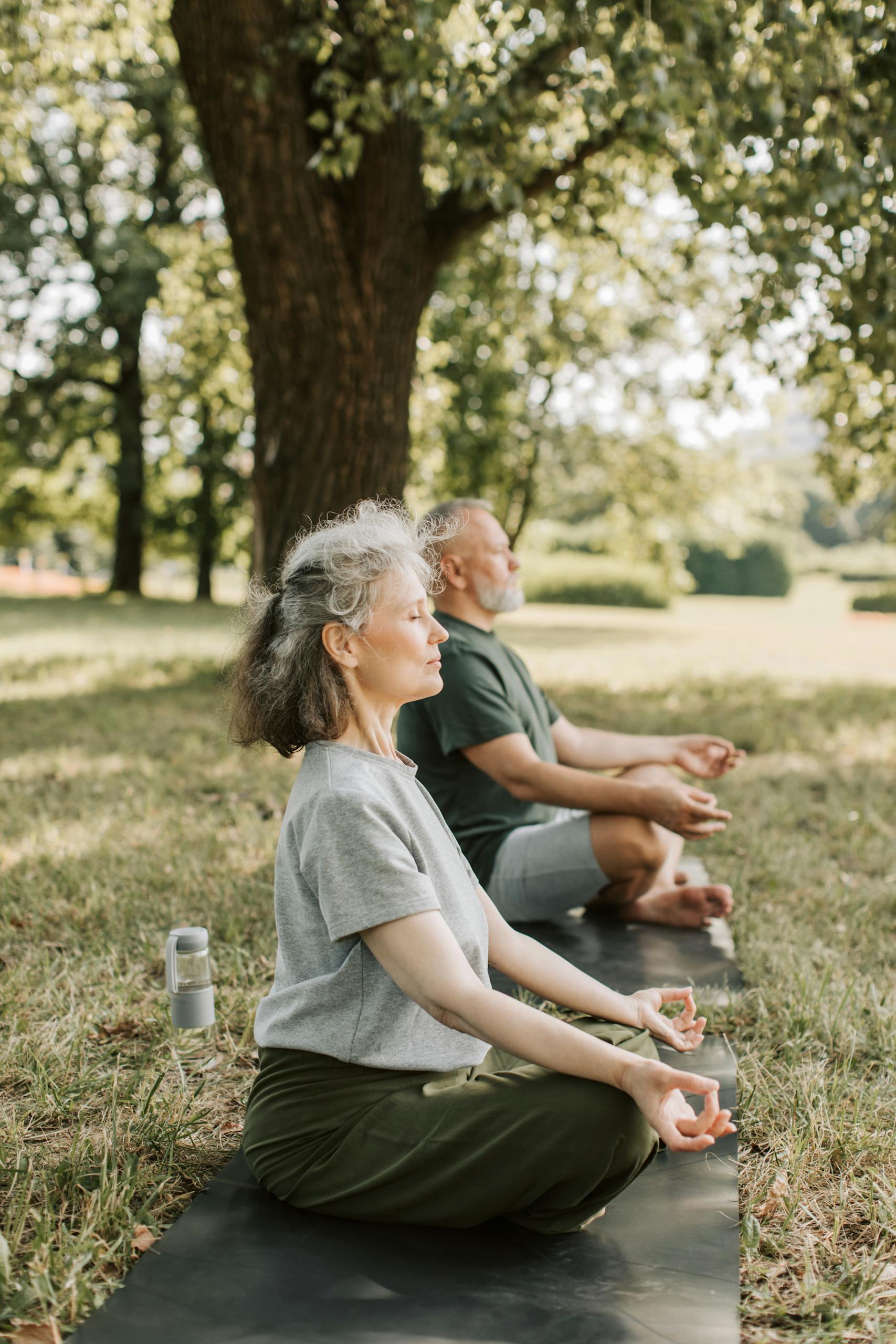
With my 1:1 yoga therapy clients, this is still the foundation, but I consider additional factors when it comes to sequencing your sessions. I’ll look at what’s going on for you on all layers: Physically, energetically, mentally, and emotionally, and I’ll plan your sessions accordingly. (I’ll leave it at that for now, because that’s an entire separate blog post.)
Put it into action!
Lifelong Yoga’s four core pillars—Alignment, Functional Movement, The Breath, and Therapeutic Sequencing—create a holistic approach that supports your journey toward better health and vibrance.
Ready to start feeling great? Join Lifelong Yoga Online today or apply for a 1:1 yoga therapy package. Discover how a little dedication to your yoga practice can make every part of your life better.

